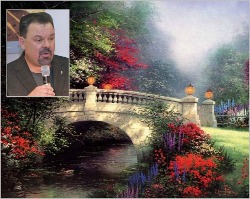 Thomas Kinkade died of “natural causes” this weekend. The self proclaimed “painter of light” left behind a wife, kids and a sizeable fortune. He made his money the old fashioned way: with huge reproduction runs. He was the Robert Wood of moral set.
Thomas Kinkade died of “natural causes” this weekend. The self proclaimed “painter of light” left behind a wife, kids and a sizeable fortune. He made his money the old fashioned way: with huge reproduction runs. He was the Robert Wood of moral set.
Morley Safer has taken heat for his hit pieces on contemporary art. Safer questioned whether or not cutting edge works qualified as art. While his assessment of Jeff Koons may have missed, his summation of Thomas Kinkade landed squarely: “If you like six sugars in your coffee, these are the paintings for you.” Complexity is an acquired taste which can be stunted with large doses of sugar.
While Koons enjoyed incredible success at the high end of the art market, Kinkade built a fortune at thousand dollar clips. It is estimated that 1 in 20 American homes contains at least one of his works. Millions more owned Kinkade trinkets like puzzles and coffee cups that have since acquired a sugary patina.
Every artist has a unique vocabulary that characterizes his work. Kinkade’s was extremely narrow. It would be easy to identify his work without a signature if not for the fact that it might be confused with a Hallmark card.
That narrow skill set appealed to a large audience. Kinkade connected with people who liked shiny objects. They bought his work on the misguided notion that it contained value. On the outside chance they you’re reading this and you own Kinkade: sell it now. Dying was the best thing he could do for those who own his work. The window is small because the Kinkade phenomena will soon follow the artist to his grave. Kitsch is kitsch, people. And it’s not worth much.
